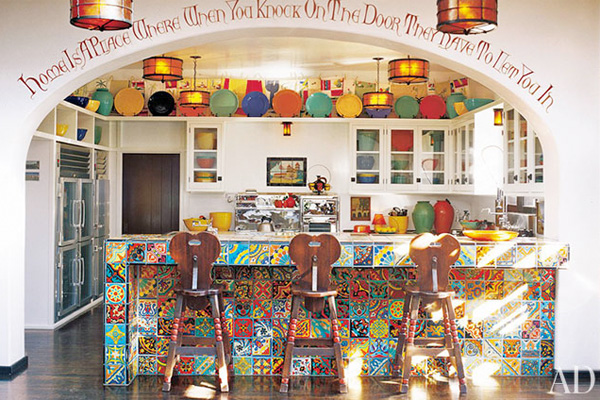Thank you so very much for all your kind comments on Spanish Colonial Architecture. I hope that you will now enjoy Spanish Colonial interiors.

Beginning in the 15th century, countries began to trade with one another by land and sea. Trade was amongst the highest between Italy, France and Spain. This is the primary reason that the design styles of Tuscan, French Country and Spanish Colonial compliment one another quite well. Because the countries traded so easily amongst one another, each adapted their own styles in the similar materials.

Spanish Colonial interiors can be quite elaborate or relatively simple in style. While the use of wrought iron is used quite prevalent, it does not appear harsh or cold as rugs, tapestries and warm colors help soften the metal.

Spanish Colonial interiors can also be quite elegant or extremely casual depending on furniture and accessory selection.

For elegant interiors you will often find hand plastered walls in a rich cream or honey yellow color. Flooring will often be parquet, rich stone or beautiful tile. Beautiful, richly colored carpets are then layered on top of the floor. Heavily carved furniture made of dark wood, generally walnut, is used.

The upholstery is often leather or rich velvets. Fireplaces are often a focal point. Tapestries and rich oil paintings cover the walls. Lighting is in the form of elaborate sconces and candelabras in wrought iron or brass.

A casual feel can be obtained with flooring made of brickwork, tile or wood that is more rustic in appearance. Ceiling beams, while used in both formal and casual rooms, are generally more present in a casual atmosphere. Dark wood furniture is still used, but in simpler styles. Leather upholstery is popular and often trimmed in nail heads. Generally window treatments are not used, but shutters and simple panels work well with this style.

For those who prefer a lighter color palette, songstress Sheryl Crow, created an inviting space in her Spanish Colonial home.

In more casual settings, plaster walls often feature colors of deep rich red, gold or blue. This design element stems from the Moroccan influence that was also encountered during the years of Spanish trading.

Architectural niches are often incorporated into a rooms design. They can be filled with religious icons, statuary, pottery or wrought iron pieces.

In dining areas you find quite a bit of candlelight, dark furniture and rich upholstery.

This dining space has a lighter look with the use of light colored leather and linen to balance the dark wood and heavy wrought iron.

This is a simple, but warm space. Urns and pottery play a large role when accessorizing a Spanish Colonial home.

Spanish Colonial style for kitchens is perfect given it’s warm and inviting look.

Kitchens will often feature bright colors. One can see the Arab influence in the glazed ceramic tiles that often feature interlocking geometric, curvilinear or floral motifs.

This kitchen belongs to actress Diane Keaton and features tile which is reminiscent of Azulejo tile which was introduced by Spain in the 15th century by the Moors who had learned the craft from the Persians. I love how the Fiesta ware pottery pops against the white walls.

Copper is a metal that is often featured in Spanish colonial homes, particularly the kitchen through pots, pans, sinks and other hardware. The copper accents pair beautifully with the turquoise cabinets.

In bedrooms color is often used profusely. This example also shows a Moorish influence.

Beds will often feature a canopy. This style remains from a time when central heating was not available and fabric panels would be closed to keep out a draft.

Bed linens are often simple matelasse, heavily embroidered cotton or silk, brocade, and in more recent years, rich chenille.

Here is a room featuring a magnificent wrought iron headboard that absolutely pops on a beautiful blue wall. This is the main focal point of the room as the rest of the furniture is fairly simple and more neutral colors are used.

Spanish accents can be brought into other areas of the home such as this wrought iron staircase and lighting, as well as the large tapestry adorning the wall.

This fireplace is the perfect picture of coziness. Notice the dark wood cabinet which is beautifully carved, wrought iron candle holders and the iconic art above the mantle. To the right of the fireplace is a chair reminiscent of the Sella Curulis which is a chair with a "X" shaped base.

Accessories are quite important in Spanish Colonial décor. Iconic art pieces, tapestry, stonework and pottery, all of which would have been collected by a world traveler or trader, are often featured. The crystal chandelier is a wee bit out of place, but I like how it elevates the more rustic pieces.

More iconic art, a beautiful mirror, and the chandelier reflected in it. The candelabra and candle holder collection is just perfection.

For those that prefer a streamline look a lovely carved table, simple lamp, religious statue and artwork are all that is needed for this stunning vignette.

A popular concept in decorating is creating outdoor living spaces. To continue the feel of a Spanish Colonial home in the outdoors you can see how the elements of dark wood, copper, wrought iron and leather can work well in a covered outdoor space.

This post was originally written on September 14, 2008. It was updated for your enjoyment and mine as I spend the week with my children who are home on fall break.
Laura

Hiç yorum yok:
Yorum Gönder